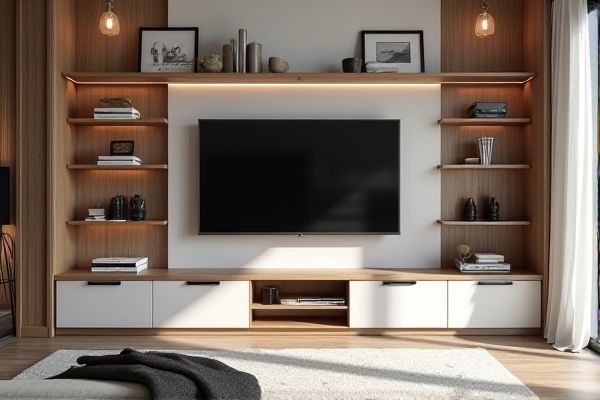
Modular wall systems offer flexible, customizable configurations that can be easily reassembled or relocated, while built-in wall units provide a permanent, seamless integration tailored to your space. Explore the article to discover which wall solution best fits your design needs and lifestyle.
Table of Comparison
| Feature | Modular Wall System | Built-in Wall Unit |
|---|---|---|
| Installation | Quick, easy to assemble and reconfigure | Permanent, requires professional installation |
| Customization | Highly customizable and flexible | Custom designed, fixed layout |
| Cost | Generally lower initial cost | Higher cost due to labor and materials |
| Durability | Moderate durability, depends on materials | High durability, built for longevity |
| Design Integration | Can be moved or adapted to different spaces | Seamlessly integrated into wall structure |
| Maintenance | Easy to maintain and replace parts | More complex maintenance, harder to modify |
| Space Efficiency | Less space efficient, may protrude | Maximizes space by built-in design |
Introduction to Modular Wall Systems and Built-in Wall Units
Modular wall systems offer customizable, flexible solutions ideal for adapting to changing spaces and storage needs, featuring pre-fabricated panels that simplify installation. Built-in wall units provide seamless, permanent storage integrated directly into the architecture, enhancing room aesthetics while maximizing space efficiency. Your choice depends on whether you prioritize adaptability with modular systems or the polished, fixed design of built-in units.
Key Differences Between Modular and Built-in Designs
Modular wall systems offer flexibility with pre-fabricated components that can be easily assembled, disassembled, and reconfigured to suit changing needs, whereas built-in wall units are permanently fixed and tailored to specific spaces, providing a seamless, custom-integrated look. Modular designs prioritize adaptability and convenience, allowing for quick installation and updates, while built-in units emphasize durability and high-end aesthetics with fixed cabinetry and finishes. Your choice depends on whether you value versatility and ease of modification or a permanent, polished installation.
Flexibility and Adaptability
Modular wall systems offer superior flexibility by enabling easy reconfiguration, expansion, or reduction to suit changing space requirements, unlike built-in wall units which are fixed and permanent. The adaptability of modular systems supports various layouts and functional adjustments without extensive construction work, providing cost-effective and time-efficient solutions. Modular components can be replaced or upgraded individually, promoting long-term versatility in dynamic environments.
Installation Process and Time Requirements
Modular wall systems offer a streamlined installation process, allowing components to be pre-fabricated and quickly assembled on-site, significantly reducing your time commitment compared to traditional built-in wall units. Built-in wall units require skilled labor for precise measurements, custom fabrication, and longer installation times due to their integration with existing structures. Choosing a modular wall system can enhance efficiency and minimize disruption during your interior renovation projects.
Cost Comparison: Modular vs. Built-in
Modular wall systems generally offer a more cost-effective solution compared to built-in wall units due to lower material and labor expenses, as they are prefabricated and easier to install. Built-in wall units often involve custom design, specialized craftsmanship, and longer installation times, significantly increasing overall costs. Your budget can benefit from the flexibility and affordability of modular options without sacrificing style and functionality.
Customization and Design Options
Modular wall systems offer extensive customization with interchangeable panels, adjustable shelving, and flexible configurations that adapt to evolving spaces and styles. Built-in wall units provide tailored design options through permanent fixtures, allowing for integrated cabinetry and seamless finishes that match architectural elements. Both solutions enable personalized aesthetics, but modular systems excel in reconfigurability while built-ins emphasize cohesion and durability.
Durability and Longevity
Modular wall systems typically feature high-quality materials such as engineered wood and metal frames, offering enhanced durability and resistance to wear compared to traditional built-in wall units made from solid wood or MDF. Their design allows for easy replacement or upgrades of individual panels, extending the overall longevity of the installation. Built-in wall units, while sturdy, may suffer from limited adaptability and are more prone to damage over time due to fixed construction methods.
Space Efficiency and Storage Solutions
Modular wall systems offer superior space efficiency by allowing customizable configurations that maximize vertical storage and adapt to changing needs in compact areas. Built-in wall units provide integrated storage solutions that blend seamlessly with architectural elements, optimizing unused wall cavities for a streamlined appearance. Both options enhance organization, but modular systems deliver greater flexibility for dynamic spaces requiring frequent reconfiguration.
Maintenance and Upgrades
Modular wall systems offer superior ease of maintenance and upgrades due to their segmented panels that can be individually replaced or repaired without disturbing the entire structure. Built-in wall units typically require more extensive disassembly for repairs, making upgrades more complex and time-consuming. The flexibility of modular systems supports quick adaptation to changing needs, reducing downtime and long-term maintenance costs.
Choosing the Right Wall System for Your Needs
Modular wall systems offer flexibility and easy customization, allowing you to adapt your space quickly with interchangeable panels and components. Built-in wall units provide a seamless, permanent solution tailored to specific dimensions and styles, enhancing the room's architectural integrity. Your choice depends on whether you prioritize adaptability or a cohesive, integrated design in your space.
 homyna.com
homyna.com